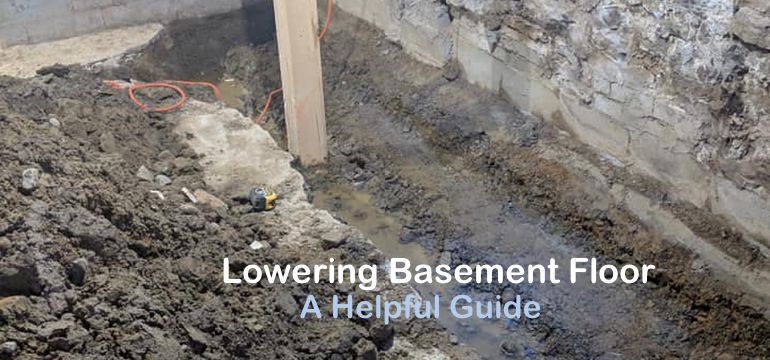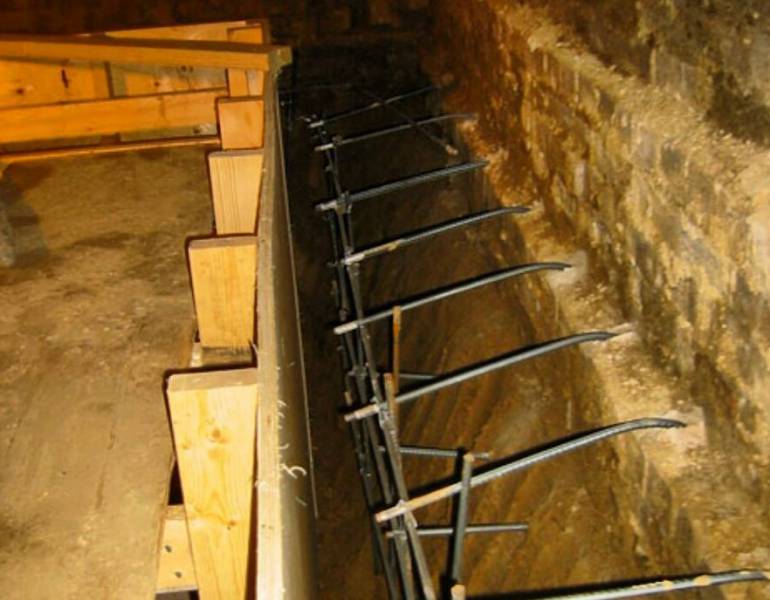Understanding the Importance of Lowering Your Basement Floor
Lowering your basement floor is a significant renovation project that can have a transformative impact on your home. By increasing ceiling height and creating additional living space, this renovation offers several key benefits. Understanding the importance of lowering your basement floor can help you make informed decisions about whether it’s the right choice for your home. Here’s why this renovation matters:
- Increased Ceiling Height: Many older homes have basements with low ceilings, which can make the space feel cramped and claustrophobic. Lowering the basement floor can significantly increase ceiling height, creating a more open and spacious environment. This increased ceiling height not only enhances the aesthetic appeal of the basement but also improves comfort and livability.
- Expanded Living Space: Lowering your basement floor effectively expands your home’s living space, providing valuable additional square footage. This expanded space can be used for various purposes, such as additional bedrooms, a home office, a recreational room, or a media room. By maximizing the usable space in your home, you can enhance its functionality and accommodate your family’s changing needs.
- Improved Structural Stability: Lowering the basement floor can also improve the structural stability of your home. In older homes, basements may have inadequate foundation support or be prone to water damage and flooding. Lowering the basement floor provides an opportunity to reinforce the foundation and implement better drainage systems, enhancing the overall structural integrity of your home.
- Enhanced Home Value: Investing in basement lowering can increase the resale value of your home. By creating additional living space and improving the overall functionality and aesthetics of the basement, you can make your home more attractive to potential buyers. A finished basement with adequate ceiling height is a desirable feature that can set your home apart in the real estate market.
- Improved Comfort and Livability: Lowering your basement floor can significantly improve the comfort and livability of your home. With increased ceiling height and expanded living space, you can create a more comfortable and functional environment for your family to enjoy. Whether you use the basement as a living area, recreational space, or storage area, lowering the floor can enhance its usability and overall appeal.

Factors to Consider Before Lowering Your Basement Floor
Lowering your basement floor is a major renovation project that requires careful consideration and planning. Before embarking on this endeavor, it’s crucial to assess the feasibility of the project and consider various factors that may impact its success. Here are some key factors to consider before lowering your basement floor:
Structural Considerations: Lowering the basement floor can have implications for the structural integrity of your home. It’s essential to assess the existing foundation and structural support systems to determine if they can accommodate the changes. Consulting with a structural engineer or contractor can help you evaluate the feasibility of lowering your basement floor and identify any necessary reinforcements or modifications.
Waterproofing and Drainage: Lowering your basement floor often involves excavating below the existing foundation, which can increase the risk of water infiltration and flooding. It’s crucial to assess the site’s drainage conditions and implement effective waterproofing measures to prevent water damage and protect your home’s foundation. Installing a reliable drainage system, such as a sump pump or French drain, can help mitigate the risk of moisture-related issues.
Permit and Building Code Requirements: Lowering your basement floor may require obtaining permits and complying with building code regulations. It’s essential to familiarize yourself with local building codes and regulations governing basement renovations and ensure that your project meets all requirements. Failing to obtain permits or comply with building codes can result in costly fines and delays.
Cost Considerations: Lowering your basement floor is a significant investment that can vary in cost depending on various factors, such as the size of the basement, the extent of excavation required, and the complexity of the project. It’s essential to carefully budget for the project and consider all associated costs, including excavation, structural modifications, waterproofing, finishing, and permits. Obtaining multiple quotes from reputable contractors can help you estimate the total cost of the project accurately.
Potential Challenges: Lowering your basement floor can present various challenges, such as encountering unexpected obstacles during excavation, dealing with existing utility lines or plumbing systems, or navigating limited access to the basement. It’s crucial to anticipate potential challenges and develop contingency plans to address them effectively. Working with experienced professionals can help you overcome obstacles and ensure the successful completion of the project.
Impact on Existing Utilities: Lowering the basement floor may require relocating or modifying existing utility lines, such as plumbing, electrical, and HVAC systems. It’s essential to assess the impact of the project on these utilities and plan accordingly to minimize disruption and ensure the continued functionality of your home’s systems. Hiring licensed professionals to handle utility modifications can help ensure compliance with safety regulations and prevent costly mistakes.
Step-by-Step Guide: Lowering Your Basement Floor
Lowering your basement floor is a complex and labor-intensive process that requires careful planning and execution. Whether you’re looking to increase ceiling height, expand living space, or improve structural stability, following a step-by-step guide can help you navigate the process effectively. Here’s a comprehensive step-by-step guide to lowering your basement floor:
Assess Structural Integrity: Before starting the project, assess the structural integrity of your home’s foundation and support systems. Consult with a structural engineer or contractor to evaluate the feasibility of lowering your basement floor and identify any necessary reinforcements or modifications.
Obtain Permits: Lowering your basement floor may require obtaining permits from local authorities and complying with building code regulations. Check with your local building department to determine the necessary permits and ensure that your project meets all legal requirements.
Plan Excavation: Plan the excavation process carefully to minimize disruption and ensure the safety of workers and occupants. Consider factors such as access to the basement, removal of excavated materials, and protection of surrounding structures and landscaping.
Excavate Basement: Excavate the basement carefully to the desired depth, taking care to avoid damaging existing utilities, plumbing, and foundation structures. Use appropriate excavation equipment and techniques to ensure the safety and efficiency of the process.
Reinforce Foundation: Depending on the extent of excavation, reinforce the foundation as necessary to support the lowered basement floor. Install additional supports, such as steel beams or concrete footings, to provide structural stability and prevent settling or shifting.
Install Waterproofing: Implement effective waterproofing measures to protect the lowered basement floor from moisture infiltration and water damage. Install a reliable drainage system, such as a sump pump or French drain, to prevent water buildup and flooding.
Modify Utilities: Modify existing utility lines, such as plumbing, electrical, and HVAC systems, to accommodate the lowered basement floor. Work with licensed professionals to relocate or modify utility lines safely and ensure compliance with safety regulations.
Pour Concrete Floor: Pour a new concrete floor to the desired level, taking care to ensure a smooth and level surface. Use high-quality concrete and proper installation techniques to create a durable and long-lasting floor.
Finish Basement: Once the concrete floor has cured, finish the basement according to your desired specifications. This may include installing flooring, walls, ceilings, and other finishes to create a functional and attractive living space.
Inspect and Test: After completing the renovation, inspect the basement and test all systems and components to ensure they are functioning properly. Address any issues or deficiencies promptly to ensure the safety and integrity of the renovated space.
Cost Considerations and Budgeting for Lowering Your Basement Floor
Lowering your basement floor is a significant home improvement project that requires careful budgeting and financial planning. Understanding the cost considerations associated with this renovation can help you make informed decisions and avoid unexpected expenses. Here’s what to consider when budgeting for lowering your basement floor:
Excavation Costs: Excavating the basement to lower the floor is one of the most significant expenses associated with this project. The cost of excavation can vary depending on factors such as the size and depth of the basement, the type of soil, and the accessibility of the site. Be sure to obtain multiple quotes from reputable contractors to compare prices and find the best value for your budget.
Structural Modifications: Lowering the basement floor may require structural modifications to reinforce the foundation and support the lowered floor. This can include installing additional supports such as steel beams or concrete footings, which can add to the overall cost of the project. Work with a structural engineer or contractor to assess the structural requirements and estimate the associated costs.
Waterproofing and Drainage: Implementing effective waterproofing measures is essential to protect the lowered basement floor from moisture infiltration and water damage. The cost of waterproofing can vary depending on factors such as the type of waterproofing system used, the size of the basement, and the extent of excavation required. Be sure to budget for waterproofing materials and labor to ensure a dry and comfortable living space.
Finishing Materials: Once the structural work is complete, you’ll need to budget for finishing materials to create a functional and attractive living space. This can include flooring, wall finishes, lighting fixtures, and electrical outlets. Choose durable and moisture-resistant materials that can withstand the unique conditions of a basement environment while staying within your budget.
Permit and Inspection Fees: Lowering your basement floor may require obtaining permits from local authorities and scheduling inspections to ensure compliance with building codes and regulations. Be sure to budget for permit fees and inspection costs, which can vary depending on your location and the scope of the project.
Contingency Fund: It’s essential to budget for unexpected expenses and unforeseen challenges that may arise during the course of the project. Set aside a contingency fund of at least 10-15% of the total project cost to cover any unexpected costs or changes in plans.
Benefits and Potential Drawbacks of Lowering Your Basement Floor
Lowering your basement floor is a significant renovation project that offers several key benefits. However, it’s essential to weigh these benefits against potential drawbacks and challenges to make an informed decision about whether this renovation is right for your home. Here’s a closer look at the benefits and potential drawbacks of lowering your basement floor:
Benefits:
Increased Ceiling Height: Lowering the basement floor can significantly increase ceiling height, creating a more open and spacious environment. This increased height enhances the aesthetic appeal of the basement and improves comfort and livability.
Expanded Living Space: Lowering the basement floor effectively expands your home’s living space, providing valuable additional square footage. This expanded space can be used for various purposes, such as additional bedrooms, a home office, or a recreational room.
Improved Structural Stability: Lowering the basement floor can improve the structural stability of your home by reinforcing the foundation and support systems. This enhances the overall structural integrity of your home and reduces the risk of settling or shifting.
Enhanced Home Value: Investing in basement lowering can increase the resale value of your home by creating additional living space and improving the overall functionality and aesthetics of the basement.
Improved Comfort and Livability: Lowering the basement floor can significantly improve the comfort and livability of your home by creating a more comfortable and functional environment for your family to enjoy.
Potential Drawbacks:
Cost: Lowering your basement floor is a significant investment that can vary in cost depending on various factors, such as the size of the basement, the extent of excavation required, and the complexity of the project.
Disruption: Lowering the basement floor can be a disruptive process that requires extensive excavation and construction work. This can disrupt daily activities and may require temporary relocation during the renovation.
Structural Challenges: Lowering the basement floor can pose structural challenges, such as encountering unexpected obstacles during excavation or dealing with existing utility lines or plumbing systems.
Waterproofing and Drainage: Lowering the basement floor increases the risk of water infiltration and flooding, necessitating effective waterproofing measures and drainage systems to prevent water damage.
Permit and Building Code Requirements: Lowering your basement floor may require obtaining permits and complying with building code regulations, adding to the complexity and cost of the project.
Lowering Basement Floor : A Helpful Guide
Lowering Basement Floor : A Helpful Guide
Can I lower the floor of the basement?
The Guide to Lowering Your Basement The Foundation Experts Inc.
How to Lower Basement Floor
Lowering Basement Floor
Cost of Underpinning: RCC Waterproofing Blog
The Pros and Cons of Basement Lowering
Underpinning Basement Basement Floor Lowering Toronto (2014)
Related Posts:
- Basement Floor Color Ideas
- Rubber Flooring For Basement
- How To Clear A Basement Floor Drain
- Basement Floor Covering Ideas
- Acid Wash Basement Floor
- Best Flooring For Concrete Basement Floor
- Insulation Under Basement Floor
- Stone Basement Floor
- Basement Floor Leveling Options
- Basement Flooring Options Inexpensive












